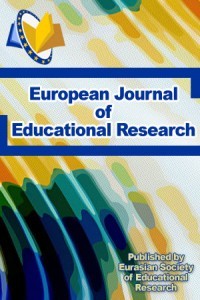The Development of an Instrument to Measure the Higher Order Thinking Skill in Physics
The Development of an Instrument to Measure the Higher Order Thinking Skill in Physics
Higher order thinking skill, physics, instrument,
___
- Adams, R., & Kho, S.-T. (1996). Acer quest version 2.1. Camberwell, Victoria: The Australian Council for Educational Research.
- Aiken, L. R. (1985). Three coefficients for analysing the reliability and validity of ratings. Educational and psychological measurement, 45(1), 131-142.
- Anderson, L. W., Krathwohl, D. R., Airasian, P., Cruikshank, K., Mayer, R., Pintrich, P., . . . Wittrock, M. (2001). A taxonomy for learning, teaching and assessing: A revision of Bloom’s taxonomy. New York. Longman Publishing.
- Artz, AF, & Armour-Thomas, E.(1992). Development of a cognitive-metacognitive framework for protocol analysis of mathematical problem solving in small groups. Cognition and Instruction, 9(2), 137-175.
- Azwar, S. (1997). Validitas dan reliabilitas (Validity and reliability). Yogyakarta, Indonesia: Pustaka Pelajar.
- Azwar, S. (2007). Validitas dan reliabilitas (Validity and reliability). Yogyakarta, Indonesia: Pustaka Pelajar.
- Barnett, J. E., & Francis, A. L. (2012). Using higher order thinking questions to foster critical thinking: A classroom study. Educational Psychology, 32(2), 201-211.
- Chetty, N. (2015). Teaching Teachers to Teach Physics to High School Learners. Procedia-Social and Behavioral Sciences, 174, 1886-1899.
- Fischer, C., Bol, L., & Pribesh, S. (2011). An investigation of higher-order thinking skills in smaller learning community social studies classrooms. American Secondary Education, 39(2), 5-26.
- Hambleton, R., Swaminathan, H., & Rogers, H. (1985). Principles and applications of item response theory. Boston, MA: Kluwer-Nijhoff Publishing Company.
- Istiyono, E. (2013). Tes Kemampuan Berpikir Tingkat Tinggi Fisika di SMA Langkah Pengembangan dan Karakteristiknya (Test of Physics High Order Thinking Skill at Senior High School: Developmental Steps and Its Characteristics) (Doctoral dissertation, Universitas Negeri Yogyakarta), Retrieved from https://eprints.uny.ac.id/22731/1/Artikel%20PDD%20PhysTHOTS.pdf.
- Istiyono, E., Mardapi, D., & Suparno, S. (2014). Pengembangan tes kemampuan berpikir tingkat tinggi fisika (pysthots) peserta didik SMA (Developing Higher Order Thinking Skill Test Of Physics (Physthots) For Senior High School Students) . Jurnal Penelitian dan Evaluasi Pendidikan, 18(1), 1-12.
- Jensen, J. L., McDaniel, M. A., Woodard, S. M., & Kummer, T. A. (2014). Teaching to the test… or testing to teach: exams requiring higher order thinking skills encourage greater conceptual understanding. Educational Psychology Review, 26(2), 307-329.
- Limbach, B., & Waugh, W. (2010). Developing higher level thinking. Journal of Instructional Pedagogies, 3, 1.
- Mardapi, D. (2008). Teknik penyusunan instrumen tes dan nontes (Techniques for preparing instruments test and non-test). Jogjakarta, Indonesia: Mitra Cendekia.
- Mardapi, D. (2012). Pengukuran penilaian dan evaluasi pendidikan (Education measurements, assessment and evaluation). Yogyakarta, Indonesia: Nuha Medika.
- Ong, K. K. A., Hart, C. E., & Chen, P. K. (2016). Promoting higher-order thinking through teacher questioning: a case study of a singapore science classroom. New Waves, 19(1), 1-19.
- Oreondo, L. L. (1984). Evaluating educational outcomes: Manila, Philippines: Rex Bookstore, Inc.
- Ozsoy-Gunes, Z., Gunes, I., Derelioglu, Y., & Kirbaslar, F. G. (2015). The reflection of critical thinking dispositions on operational chemistry and physics problems solving of engineering faculty students. Procedia-Social and Behavioral Sciences, 174, 448-456.
- Polit, D. F., & Beck, C. T. (2006). The content validity index: are you sure you know what's being reported? Critique and recommendations. Research in nursing & health, 29(5), 489-497.
- Ramadhan, S., & Mardapi, D. (2015). Estimasi Kesalahan Baku Pengukuran Soal-Soal UAS Fisika Kelas XII SMA di Kabupaten Bima NTB (the estimation the standard error of measurement in physics end-of-semester tests of senior high schools in kabupaten Bima, NTB). Jurnal Evaluasi Pendidikan, 3(1), 90-98.
- Retnawati, H. (2016). Validitas reliabilitas dan karakteristik butir (Validity, reliability and item charactheristic). Yogyakarta, Indonesia: Parama Publishing.
- Snyder, L. G., & Snyder, M. J. (2008). Teaching critical thinking and problem solving skills. The Journal of Research in Business Education, 50(2), 90.
- Ten Dam, G., & Volman, M. (2004). Critical thinking as a citizenship competence: teaching strategies. Learning and instruction, 14(4), 359-379.
- Wang, S., & Wang, H. (2011). Teaching higher order thinking in the introductory MIS course: A model-directed approach. Journal of Education for Business, 86(4), 208-213.
- Wang, S., & Wang, H. (2014). Teaching and learning higher-order thinking. International Journal of Arts & Sciences, 7(2), 179.
- © 2012-2019 Powered by Eurasian Society of Educational Research European Journal of Educational Research ISSN: 2165-8714
- ISSN: 2165-8714
- Başlangıç: 2012
- Yayıncı: Eurasian Society of Educational Research
Interplay between Politics and Institution in Higher Education Reform
Greek Teachers’ Perceptions about the Types and the Consequences of Conflicts within School Context
Nikolaos MANESİS, Elisavet VLACHOU, Foteini MİTROPOULOU
Reflections of Fears of Children to Drawings
Investigating the Academic Motivations and Academic Achievements of Pre-Service Visual Arts Teachers
Scientific Approach to Promote Response Fluency Viewed from Social Intelligence: Is It Effective?
Technology-Supported Teaching: Technological Progress or a Sham?
Eyal ECKHAUS, Nitza DAVİDOVİTCH
Gilbert C. MAGULOD JR., Juvelyn D. CAPİLİ, Roselyn M. PİNON
The Development of an Instrument to Measure the Higher Order Thinking Skill in Physics
Syahrul RAMADHAN, Djemari MARDAPİ, Zuhdan Kun PRASETYO, Heru Budi UTOMO
